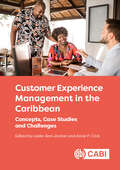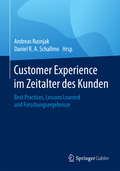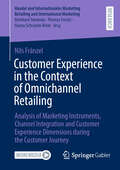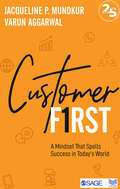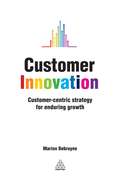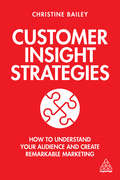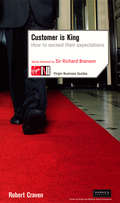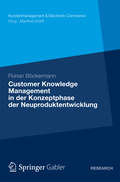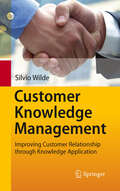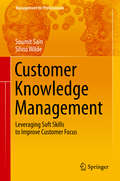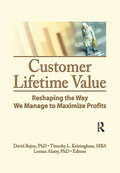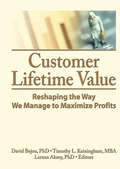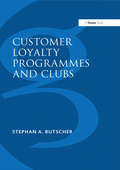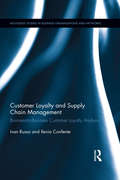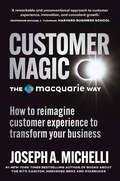- Table View
- List View
Customer Experience Management in the Caribbean: Concepts, Case Studies and Challenges
by Paul Anderson Michelle McLeod Trevor A. Smith Sumit Verma Elaine Commissiong Noel M. Cowell G. Anthony Ferguson Koen Hietbrink Jacqueline Huggins Candice Petgrave Juliana Samuel Tiersa Smith-Hall Evora Mais Thompson Nadane Y. WrightDiving into the evolution of Customer Experience this text offers an insightful exploration of the paradigm shift from customer service to Customer Experience (CX) within the Caribbean context. Unveiling the dynamics of CX's influence on satisfaction, loyalty, and business profitability, this book delves into strategic planning, employee development, data-driven decisions, and emerging technological trends, and it fills a crucial gap in the literature with: - An array of Caribbean case studies; - Enhanced theoretical concepts and a deep appreciation of customer experience management in the Caribbean; - References of best practices to address critical issues affecting the delivery of a quality customer experience. Scholars and practitioners within customer service, services marketing, customer experience management and customer relationship marketing in the retail hospitality and tourism, financial, health care and education sectors will find this a valuable resource on CX's transformative power in this region and beyond.
Customer Experience im Zeitalter des Kunden: Best Practices, Lessons Learned und Forschungsergebnisse
by Daniel R. A. Schallmo Andreas RusnjakDieser Band widmet sich Themen zum Customer Experience Management und bietet anhand von Best-Practice-Beispielen unterschiedlichster Branchen, Fallstudien und empirischen Untersuchungen einen umfassenden #65533;berblick. Im Zeitalter des Kunden werden auf Dauer nur die Unternehmen erfolgreich sein, die ihren Kunden au#65533;ergew#65533;hnliche Erlebnisse und einen #65533;berlegenen Nutzen bieten. Hierbei ist es wichtig, das Verhalten und die Erwartungen von Kunden so gut wie m#65533;glich zu verstehen und entlang von Customer Journeys und Touchpoints zu gestalten. Die Beitr#65533;ge zeigen Ans#65533;tze, Hintergr#65533;nde und Konzepte, wie Unternehmen das Customer Expericence Management effektiv einsetzen k#65533;nnen.
Customer Experience in Fashion Retailing: Merging Theory and Practice (Mastering Fashion Management)
by Bethan AlexanderThis text provides a holistic, integrated and in-depth perspective on the growing field of customer experience (CX), in a fashion context.Merging three core perspectives – academic, creative agency and retailer – the book takes a chronological approach to tracing the evolution of customer experience from the physical store, to omnichannel through channel convergence to consider the future of fashion retailing and customer experience. Beginning with the theoretical perspective, customer experience evolution in a fashion retail context is traced, considering the definition of customer experience, physical retail, the digitalisation of customer experience, omni-channel retail, in-store technologies and envisioning future retail CX. The retail creative agency perspective looks at how to locate and design customer experience journeys, designing harmonised CX across retail brand environments online and offline, responsible retailing and taking a human-centric approach to create visceral, wellbeing-based experiences. Finally, the retailer perspective explores real-life case studies of great customer experience from international brands, including Zara, Nike, Ecoalf, To Summer and Anya Hindmarch. Pedagogical features to aid understanding are built in throughout, including chapter objectives and reflective questions.Comprehensive and unique in its approach, Customer Experience in Fashion Retailing is recommended reading for students studying Fashion Retail Management, Customer Experience, Retail Design and Visual Merchandising, Fashion Psychology and Fashion Marketing.
Customer Experience in the Context of Omnichannel Retailing: Analysis of Marketing Instruments, Channel Integration and Customer Experience Dimensions during the Customer Journey (Handel und Internationales Marketing Retailing and International Marketing)
by Nils FränzelThe research focus of Nils Fränzel is on customer behaviour in omnichannel retailing. He focuses on the multidimensionality of customer experience and the reciprocal interactions between different dimensions of customer experience. He also looks at the importance of channel specific marketing instruments and channel integration along the customer journey. Nils Fränzel's analysis contributes to the latest research in the field of customer experience in omnichannel retailing and shows the importance of the different stages of the customer journey.
Customer First: A Mindset That Spells Success in Today’s World
by Varun Aggarwal Jacqueline P. MundkurHow often have you complained about poor customer experience at a hotel, an airport, with your telecom operator or even with your neighborhood grocery store? Our guess is more often than you would like. From the biggest global technology companies to the most customer-friendly brands, there are aspects to customer experience that go amiss despite large budgets or industry best practices. Through 13 relatable stories from Indian businesses, Customer First highlights lapses in customer experience efforts and how these issues were tackled or could have been successfully tackled.
Customer Genius
by Peter FiskHello, I am your customer. Do you see the world like I do? It's simple really. Start with me and everything else follows. Together we can do extraordinary things. Are you ready? 10 building blocks, 30 practical tools, 50 inspirational stories. From Amazon to Banyan Tree, Quintessentially to Zipcars, explore 50 of the world's leading customer businesses. The rise of Air Asia, and the collaboration of Boeing; the segmented focus of Club Med, and the customer vision of Disney; the imagination of Camper, and the desire for the Nintendo Wii; the realism of Dove, and the tribal loyalty of Harley Davidson. The 'genius' of a customer-centric business is that it works from the outside in. It attracts, serves and retains the best customers as its route to profitability and growth. Isn't it about time you started doing business from the outside in?
Customer Innovation
by Marion DebruyneA new set of organisations have discovered a new formula. They combine customer centricity with innovative power. These organisations have created a completely outside-in approach to the market. They are not driven by what they're good at. They start with the market and design their strategy around it. They replace practices of the past with a new set of capabilities, which enable them to be ahead of the curve in discovering new market opportunities. This enable them to develop new products and services faster than ever before and they hit the bull's eye in the market. Whereas the traditional value chain model regards the market as the end-outcome of the efforts of the organisation, the reversed value chain model starts there. The customer is the starting point and the value chain is the result of understanding customer needs and requirements. Packed with real world examples from a range of leading global companies including Disney, Coca-Cola, LEGO, Eurex, Netflix, KLM, Carglass, Komatsu, Callebaut and more, Marion Debruyne's provides every business with the framework it needs to combine customer focus with innovation to achieve success.
Customer Innovation: Delivering a Customer-Led Strategy for Sustainable Growth
by Marion Debruyne Koen TackxMany organizations approach customer-centic marketing and innovating their business strategy in isolation to one another, missing groundbreaking opportunities for advancement. Customer Innovation, second edition, turns this on its head by starting with the customer, innovating around their needs, then building a customer led business strategy around it. It presents a well-constructed three-by-three formula of connect, convert, collaborate, laying the foundations for innovation and change, to improve the current customer journey and expand into new customer horizons. This enables new product and service development to flow with outstanding efficiency and substantial growth. Customer Innovation, second edition, includes exciting updates around co-creation and the benefits of involving customers, stakeholders and employees from the beginning. It provides guidance on using technology to reinvent traditional business models, with consumer needs at the heart. With a spectacular range of case studies, including Disney, LEGO and Johnson & Johnson, all delivered with active takeaways, this is the ultimate handbook for any leader, business or marketing strategist, ready to pave the way in a new era of customer led strategy.
Customer Insight Strategies: How to Understand Your Audience and Create Remarkable Marketing
by Dr Christine BaileyIn a noisy, fast-paced marketing world, customer insight holds the key to creating memorable, purpose-driven marketing. Customer Insight Strategies outlines the critical role of customer insight and provides techniques and strategies that will help marketers identify trends, nurture leads and understand consumers - ultimately, empowering them to grow profits. The strategies are explained in a straightforward, jargon-free manner, and can be applied to a huge range of marketing challenges, regardless of time, budget or organizational size.Customer Insight Strategies shows precisely how customer insights can be used to build a mission with purpose. It discusses many of the core methods through which customer insight can be gleaned, providing easy-to-follow guidelines for applying them to everyday marketing practice. Covering topics such as customer segments, marketing to personas and lead generation, it contains global case studies from organizations including Cisco, NTT, Refinitiv and The Co-op as well as interviews with leading business professionals sharing their thoughts on using customer insights to grow profits. Written by a highly respected thought-leader and industry influencer, this book will help any professional create truly powerful marketing.
Customer Insights mit Archetypen: Wie Sie mit archetypischen Metaphern Zielgruppen besser definieren und verstehen können (essentials)
by Jens Uwe Pätzmann Yvonne AdamczykJedes Unternehmen möchte seine Kunden bestmöglich verstehen und jagt nach Customer Insights, um motivationale Barrieren und Verstärker der Zielgruppe im Hinblick auf Geschäftsmodelle, Produktinnovationen, Service Design, Personas, Creative Briefs, Claims und Storytelling besser verstehen zu können. Die Autoren zeigen, wie man archetypische Metaphern, z.B. den Fels in der Brandung, nutzt, um Customer Insights zu identifizieren, die das kollektive Unbewusste ansprechen, Emotionen erzeugen und dadurch Handlungen auslösen. Ergebnis ist ein Kompass, der den Weg zu treffgenauen inneren Bildern aufzeigt.
Customer Insights: Kundenbedürfnisse und Konsumentenverhalten verstehen
by Jonas RashediDieses Buch stellt Erhebungstechniken, Analysetechniken und Modelle vor, die dabei helfen, Kundenbedürfnisse besser zu verstehen und zu bedienen. Nur wenn wir verstehen, was einen Kunden bewegt und welche Faktoren welchen Einfluss auf sein Verhalten haben, können wir die einzelnen Touchpoints der Kundenreise zielorientiert gestalten, im besten Fall individualisiert und angepasst für den einzelnen Kunden. Durch die Digitalisierung stehen an den einzelnen Offline- und Online-Touchpoints immer mehr digitale Daten zur Verfügung. Immer performantere IT-Lösungen, das maschinelle Lernen sowie neuronale Netze erlauben es uns, diese umfangreichen Datenmengen zu diesem Zweck auszuwerten. Jonas Rashedi zeigt kompakt und praxisnah, wie das gelingt.
Customer Intimacy and Other Value Disciplines
by Fred Wiersema Michael Treacy Frederik D. WiersemaTo today's customers, value can mean any number of things, from convenience of purchase to after-sale service and dependability. But that doesn't mean companies have to excel at everything. A study of over 40 companies found that market leaders like Dell Computer, Home Depot, and NIKE succeed by narrowing their business focus, not by broadening it. They concentrate on one of three value disciplines--operational excellence, customer intimacy, or product leadership--and align their entire operating model to serve that discipline. Companies should choose a value discipline that fits with their existing capabilities and culture and then push themselves relentlessly to sustain it. And they should willingly change their operations to support that value discipline.
Customer Is King: How to Exceed Their Expectations
by Robert CravenUpdated eBook editionWhat happens to your customers when you do business with them? Customer is King helps you to approach the problem from the point of view of the clients and work towards the level of customer satisfaction that makes them come back to you again and again.Practical and packed full of easy-to-understand advice, you'll find:* checklists and worksheets* case studies of real businesses* frequently asked questions
Customer Knowledge Management in der Konzeptphase der Neuproduktentwicklung (Kundenmanagement & Electronic Commerce)
by Florian BöckermannDie kontinuierliche Entwicklung und Vermarktung von Neuprodukten ist eine zentrale Voraussetzung für den nachhaltigen Geschäftserfolg von Unternehmen. Dabei ist die Generierung sowie sorgfältige Verarbeitung und Nutzung des Kundenwissens essenziell. Auf Basis theoretischer und empirischer Erkenntnisse sowie einer qualitativen Studie entwickelt Florian Böckermann ein Customer Knowledge Management (CKM)-Konzept, in welchem das im Rahmen der Neuproduktentwicklung besonders relevante spezifische Wissen der Kunden berücksichtigt wird. Auf Grundlage einer industrieübergreifenden empirischen Untersuchung gibt der Autor Hinweise zur Gestaltung des CKM in der Konzeptphase der Neuproduktentwicklung sowie eines Unternehmensumfeldes zur effektiven Umsetzung von CKM. Er zeigt darüber hinaus, dass CKM einen positiven Einfluss auf den Innovations- und Unternehmenserfolg besitzt.
Customer Knowledge Management: Improving Customer Relationship through Knowledge Application (Management for Professionals)
by Silvio WildeManaging and transferring knowledge - at the right time, in the right place and with the right quality for customers - enables companies to survive in times of fierce competition. The focus of this work is therefore on Knowledge Management and Customer Relationship Management. The theoretical part comprises several approaches to knowledge, its transfer and the barriers to be overcome when sharing knowledge. This is followed by a description of CRM and CKM (Customer Knowledge Management), outlining how crucial their successful use is. The practical part explores on the one hand the dependence on knowledge and on the other hand its availability for a good customer relationship. It includes a case study that investigates both the administrative and the operational area of a concrete company. The survey results are then discussed in detail, key success factors identified and mistakes pointed out. After this critical analysis, final recommendations are given that every company can benefit from.
Customer Knowledge Management: Leveraging Soft Skills to Improve Customer Focus (Management for Professionals)
by Silvio Wilde Soumit SainCustomer focus is the most important challenge of the future. Providing good customer service depends on how well companies know their customers and clearly identify their needs. Availability of customer knowledge, which is knowledge from, for and about the customer, thus becomes crucial in offering customized products or services. This can be gained most efficiently from direct interaction with customers, but requires the use of interpersonal and organizational soft skills. This book presents the interrelationship between customer knowledge management, customer focus and soft skills and also provides concrete advice on how the management of customer knowledge can be optimized.
Customer Lifetime Social Value (CLSV)
by Elie Ofek Barak Libai Eitan MullerOne of the hallmarks of the digital revolution is the rise of the socially-connected consumer. Concomitantly, the ability of companies to affect and measure the social interactions among customers has grown tremendously. Consequently, in assessing the full value of each customer to the firm it is no longer sufficient to only consider a customer's worth in terms of the discounted cash flows he or she provides through direct payments, it is also critical to incorporate the indirect value generated through the customer's social influence. In this note we develop a framework for measuring and quantifying the social value that a customer generates. We derive a simple expression for Customer Social Value (CSV) and show how to combine it with the commonly used expression for Customer Lifetime Value (CLV). The combined entity is termed Customer Lifetime Social Value (CLSV). The note uses concrete examples to illustrate the main ideas and explores a host of issues related to how customers create value for the firm through their social interactions, such as the duration of social influence, reduction in acquisition costs, segmentation implications, relevance for influencer marketing programs, and connection to firm-level valuation.
Customer Lifetime Value (CLV) vs. Customer Lifetime Return on Investment (CLROI)
by Elie OfekThis note presents two related measures for assessing the financial value of a customer to the firm. The first is the well-known measure of Customer Lifetime Value, or CLV for short. The second, which has received much less attention, treats the acquisition of a customer as a financial investment that has a quantifiable return based on future profit streams. Accordingly, we term this latter measure Customer Lifetime Return on Investment, or CLROI for short, and explain how it is calculated. We further show how employing CLROI can yield wildly different marketing implications relative to CLV (despite the strong link between them), particularly for targeting decisions. The note provides multiple examples to illustrate the concepts and also introduces formal characterizations of the two measures. The relevance of segment sizes, customer dynamics, social network influences, and strategic considerations are discussed.
Customer Lifetime Value: Reshaping the Way We Manage to Maximize Profits
by Lerzan Aksoy Timothy L. Keiningham David BejouGet the competitive edge by effectively managing customer lifetime valueThe customer lifetime value (CLV) concept is extensively changing the way today&’s business is managed. A student or practitioner needs to understand CLV to best gain the competitive edge in business. Customer Lifetime Value: Reshaping the Way We Manage to Maxi
Customer Lifetime Value: Reshaping the Way We Manage to Maximize Profits
by Lerzan Aksoy Timothy L. Keiningham David BejouGet the competitive edge by effectively managing customer lifetime valueThe customer lifetime value (CLV) concept is extensively changing the way today&’s business is managed. A student or practitioner needs to understand CLV to best gain the competitive edge in business. Customer Lifetime Value: Reshaping the Way We Manage to Maximize Profits is a text that shows in detail how managers and researchers can best use CLV to a business&’s advantage. This valuable resource explores various practical approaches to the measurement and management of customer value that focus on maximizing profitability and growth. Leading thinkers discuss how to leverage CLV in all aspects of business, including customer management, employee management, and firm valuation. Everyone needing to prepare a business for success in the future should read this book.Most books on the subject only cover separate components of CLV and are typically limited to targeting for direct response marketing. Customer Lifetime Value presents all components, cohesively putting them together into an understandable functioning whole. This source prepares forward-looking managers and researchers for the inevitable change and provides strategies to gain and sustain the competitive advantage. Topics in Customer Lifetime Value include: leveraging the customer database to maximize CLV using CLV in customer segmentation customer divestment using CLV in firm valuation setting up an organization designed to maximize CLV much more! Customer Lifetime Value: Reshaping the Way We Manage to Maximize Profits is essential reading for practitioners in the areas of customer satisfaction, loyalty, CRM, and direct response, as well as academics in the service marketing area.
Customer Loyalty Programmes and Clubs
by Stephan A. ButscherIn every industry, and any company, customer loyalty marketing is an important pillar of corporate strategy. This second edition of Customer Loyalty Programmes and Clubs, explains how the key to effective protection against competition lies in identifying and offering your customers the right combination of financial and non-financial benefits. Stephen Butscher has reviewed the developments that have taken place since his original successful step-by-step guide was published and now includes 'pricing for customer loyalty' and 'e-loyalty' along with extra case studies. He takes you through all the necessary stages to research, plan and launch a programme that builds and develops the relationship between you and your customers, and emphasises value measurement and selection of the right benefits, enabling you to integrate the loyalty programme into every part of your organization. Customer Loyalty Programmes and Clubs includes case studies from some of the most successful companies, including Volkswagen Club, Kawasaki Riders Club, Swatch the Club, Porsche and many more.
Customer Loyalty Schemes in the Retail Sector
by Aldo Sesia Jose B. AlvarezCustomer loyalty schemes (or programs) are explicit efforts by retailers to gain long-term patronage from customers. Loyalty schemes are developed for a variety of reasons: to reward loyal customers, to generate more robust information about customer behavior, to influence consumer behavior, and as a defensive measure to combat a competing scheme. The purpose of this note is to describe the objectives of these schemes, including their origin and evolution; to highlight key aspects of their implementation; and to suggest approaches to maximize their impact. While this note focuses on the U.S. and U.K. retail sectors, most of its content is applicable to other economies.
Customer Loyalty and Supply Chain Management: Business-to-Business Customer Loyalty Analysis (Routledge Studies in Business Organizations and Networks)
by Ivan Russo Ilenia ConfenteMany business-to-business (B2B) managers think that customers act rationally and base decisions mostly on price, customer loyalty isn’t considered. Companies outsource various activities, which enable them to improve efficiency, reduce costs, focus more on core competencies and improve their innovation capabilities. Supply Chain Management synchronizes the efforts of all parties—particularly suppliers, manufacturers, retailers, dealers, customers—involved in achieving customer’s needs. Despite much research, the relationship between customer loyalty and the supply chain strategy remains insufficiently explored and understood by practitioners and academics, while the theme has been extensively developed within marketing literature. Customer Loyalty and Supply Chain Management is the result of years of work by the authors on different projects concerning the overlapping areas of supply chains, logistics and marketing, drawing a connection between the literature to provide a holistic picture of the customer loyalty framework. Emphasis is given to the B2B context, where recent research has provided some clues to support the fact that investment in operations, new technologies and organizational strategy have had a significant role in understanding B2B loyalty, particularly in the context of global supply chains. Moreover, the book provides a modernized and predictive model of B2B loyalty, showing a different methodological approach that aims at capturing the complexity of the phenomenon. This book will be a useful resource for professionals and scholars from across the supply chain who are interested in exploring the dimension of customer loyalty in the challenging supplier and customer context.
Customer Magic – The Macquarie Way: How to Reimagine Customer Experience to Transform Your Business
by Joseph A. MichelliIt takes a special kind of magic for a challenger brand to achieve seemingly impossible customer-centric results. It' s that magic that makes Australian telecommunications company Macquarie Technology world leaders in award-winning customer experience. Joseph A. Michelli – the bestselling author of books about brands renowned for their stellar service and outstanding growth, such as The Ritz-Carlton, Mercedes-Benz and Starbucks – was so impressed by Macquarie' s ability to deliver transformative customer experiences that he felt compelled to write this book. Customer Magic is a practical, easy-to-read guide that, consistent with Macquarie' s commitment to delivering customer value, shares transferrable knowledge on how to identify and solve customer pain points; craft a compelling unique value proposition; attract, select, grow and retain customer service talent and subject matter expertise; set, measure, track and incentivise mission-critical business goals and customer-driven growth; innovate solutions that meet your customers' stated and unstated needs; and maintain a growth mindset and leave a legacy of success.
Customer Management Dynamics and Cohort Analysis
by Elie Ofek Barak Libai Eitan MullerThe digital revolution has allowed companies to amass considerable amounts of data on their customers. Using this information to generate actionable insights is fast becoming a critical skill that firms must master if they wish to effectively compete and win in today's data-driven marketplace. This note explains the value of examining customer metrics, such as retention rate, revenues, and social influence (k-factor), on an ongoing basis by conducting a cohort analysis. Such an analysis segments customers using one or more criteria, and tracks the behavior and performance of each of these segments over time. Using several instructive examples, the presentation highlights the benefits of running a cohort analysis for deriving a deep understanding of customer trends. Moreover, the examples expose the pitfalls that arise from not accounting for segment characteristics (such as when a customer joined, from what media vehicle they were acquired, how heavily they use the product, etc.) and not paying attention to the evolution of customer metrics over time. The implications of conducting a cohort analysis for firm strategy and for determining customer lifetime value (CLV) are discussed.
